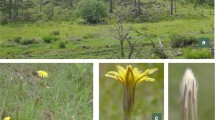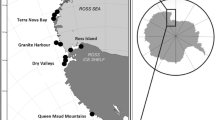Abstract
To clarify the genetic status and provide effective information for the conservation of Athyrium viridescentipes, a critically endangered fern species with only 103 individuals remaining in the wild, we conducted ubiquitous genotyping to determine the genotypes of all remnant individuals of the target species. We analyzed the genetic variation of the 103 known individuals in four populations by using 13 microsatellite loci. The genotypes of single spores from a sporophytic individual were also determined in order to reveal the breeding system of this species. The level of allelic variation in A. viridescentipes was significantly lower than that of closely related Athyrium species. The genetic composition of the four populations was rather similar. Sixty-nine individuals (67%) possessed an identical pattern in the allele combinations at 13 microsatellite loci. The mean pairwise F ST among four populations was 0.018. The segregated pattern of alleles, determined by single-spore genotyping, revealed that allelic recombination occurs through meiosis. The results indicate that this species contains a low level of genetic variation, has low population differentiation, and maintains populations by sexual reproduction. These findings could lead to more effective conservation programs, the selection of the most appropriate individuals for ex situ conservation efforts, and separate management of extant populations.

Similar content being viewed by others
References
Adjie B, Takamiya M, Ohta M, Ohsawa TA, Watano Y (2008) Molecular phylogeny of the lady fern genus Athyrium in Japan based on chloroplast rbcL and trnL-trnF sequences. Acta Phytotaxonomica et Geobotanica 59:79–95
Bachmann K (1994) Molecular markers in plant ecology. New Phytol 126:403–418
Brown AHD, Young AG (2000) Genetic diversity in tetraploid populations of the endangered daisy Rutidosis leptorrhynchoides and implications for its conservation. Heredity 85:122–129
Chen YY, Yang W, Li W, Li ZZ, Huang HW (2009) High allozyme diversity and unidirectional linear migration patterns within a population of tetraploid Isoetes sinensis, a rare and endangered pteridophyte. Aquat Bot 90:52–58
Crutsinger GM, Collins MD, Fordyce JA, Gompert Z, Nice CC, Sanders NJ (2006) Plant genotypic diversity predicts community structure and governs an ecosystem process. Science 313:966–968
Frankham R (1995) Conservation genetics. Annu Rev Genet 29:305–327
Frankham R, Ballou JD, Briscoe DA (2002) Introduction to conservation genetics. Cambridge University press, Cambridge
Guo Q, Kato M, Ricklefs RE (2003) Life history, diversity and distribution: a study of Japanese pteridophytes. Ecography 26:129–138
Iwatsuki K (1992) Ferns and fern allies of Japan. Heibonsha, Tokyo, Japan (in Japanese)
Izuno A, Takamiya M, Kaneko S, Isagi Y (2011) Microsatellite loci in an endangered fern species Athyrium viridescentipes (Woodsiaceae) and cross-species amplification. Am J Bot 98:e339–e341
Jiménez A, Holderegger R, Csencsics D, Quintanilla LG (2010) Microsatellites reveal substantial among-population genetic differentiation and strong inbreeding in the relict fern Dryopteris aemula. Ann Bot 106:149–155
Kang M, Huang H, Jiang M, Lowe AJ (2008) Understanding population structure and historical demography in a conservation context: population genetics of an endangered fern. Divers Distrib 14:799–807
Kurata S (1965) Notes of Japanese ferns (35). J Geobot 13:75
Lloyd RM (1974) Reproductive biology and evolution in the pteridophyta. Ann Mo Bot Gard 61:318–331
Macgraw JB, Furedi MA (2005) Deer browsing and population viability of a forest understory plant. Science 307:920–922
Masuyama S (1975) The sequence of the gametangium formation in homosporous fern gametophytes. II. Types and their taxonomic distribution. Sci Rep Tokyo Kyoiku Daigaku 16:71–86
Matsuki Y, Isagi Y, Suyama Y (2007) The determination of multiple microsatellite genotypes and DNA sequences from a single pollen grain. Mol Ecol Note 7:194–198
Milligan B (1992) Plant DNA isolation. In: Hoelzel AR (ed) Molecular genetic analysis of populations: a practical approach. IRL Press, Oxford, pp 59–88
Ministry of the environment (2007) Threatened wildlife of Japan—red data book. In: Center JWR (ed) Vascular plants. Japan Wildlife Research Center, Tokyo, Japan
Moran RC (2008) Diversity, biogeography, and floristics. In: Ranker TA, Haufler CH (eds) Biology and evolution of ferns and Lycophytes. Cambridge University Press, Cambridge, pp 367–394
Powell W, Morgante M, Andre C, Hanafey M, Vogel J, Tingey S, Rafalski A (1996) The comparison of RFLP, RAPD, AFLP, and SSR (microsatellite) markers for germplasm analysis. Mol Breed 10:1881–1889
Pryor KV, Young JE, Rumsey FJ, Edwards KJ, Bruford MW, Rogers HJ (2001) Diversity, genetic structure and evidence of outcrossing in British populations of the rock fern Adiantum capillus-veneris using microsatellites. Mol Ecol 10:1881–1894
Puyvelde KV, Geert AV, Triest L (2010) ATetra, a new software program to analyse tetraploid microsatellite data: comparison with Tetra and Tetrasat. Mol Ecol Res 10:331–334
R development core team (2010) R: a language and environment for statistical computing, version 2.12.1. R foundation for statistical computing, Vienna, Austria. http://www.R-project.org/
Ranker TA, Gemmill CEC, Trapp PG (2000) Microevolutionary patterns and processes of the native hawaiian colonizing fern Odontosoria chinensis (Lindsaeaceae). Evolution 48:828–839
Sunnucks P (2000) Efficient genetic markers for population biology. Trends Evol Ecol 15:199–203
Takamiya M (1996) Index to chromosomes of Japanese pteridophyta (1910–1996). Japan Pteridological Society, Tokyo
Takatsuki S (2009) Effects of sika deer on vegetation in Japan: a review. Biol Conserv 142:1922–1929
Vitalis R, Riba M, Colas B, Grillas P, Olovoeri I (2002) Multilocus genetic structure at contrasted spatial scales of the endangered water fern Marsilea Strigosa Willd. (Marsileaceae, Pteridophyta). Am J Bot 89:1142–1155
Woodhead M, Russell J, Squirrell J, Hollingsworth PM, Mackenzie K, Gibby M, Powell W (2005) Comparative analysis of population genetic structure in Athyrium distentifolium (Pteridophyta) using AFLPs and SSRs from anonymous and transcribed gene regions. Mol Ecol 14:1681–1695
Wright S (1969) Evolution and the genetics of populations, vol. 2. The theory of gene frequencies. University of Chicago Press, Chicago
Acknowledgments
This research was supported by Grants in Aid for Scientific Research (20241056) from the Japan Society for the Promotion of Science and the Environment Research and Technology Development Fund (D-0903) of the Ministry of the Environment, Japan.
Author information
Authors and Affiliations
Corresponding author
Electronic supplementary material
Below is the link to the electronic supplementary material.
Table S1–S4 Alleles detected in 13 microsatellite loci and identification of MLACs for all individuals of the 4 species analyzed in this study: Athyrium viridescentipes (Table S1), A. otophorum (Table S2), A. kuratae (Table S3), and A. vidalii (Table S4). “N” indicates a null allele, which is regarded as being the same as the dominant allele in determining MLACs. For single spore genotyping, spores were collected from Individual 16 of A. viridescentipes.
Rights and permissions
About this article
Cite this article
Izuno, A., Takamiya, M., Kaneko, S. et al. Genetic variation and structure of the endangered Lady Fern Athyrium viridescentipes based on ubiquitous genotyping. J Plant Res 125, 613–618 (2012). https://doi.org/10.1007/s10265-012-0482-x
Received:
Accepted:
Published:
Issue Date:
DOI: https://doi.org/10.1007/s10265-012-0482-x




